Time to hedge in VIX and USD

Wagner's attempted coup in Russia on Midsummer's Day unexpectedly little affected the market. We believe in a flight to safety where the USD and, even more so, the US volatility index VIX are currently at attractive levels.
Case of the week: Geopolitics could bolster the US dollar
Will the fog of war cloud financial markets again?
An attempted and eventually abandoned coup d’état by the mercenary Wagner group in Russia and Ukraine´s ongoing counteroffensive to reclaim Russian-occupied territories are signs that the war’s stalemate might be ending. This could break the relative calm in financial markets of recent months. It is likely that the positive performance in equity markets so far in 2023 has at least partly been underpinned by the lack of any significant development in the war. This has contributed to energy and commodities prices retreating, easing inflationary pressures.
Neither Russia nor Ukraine seems ready for peace talks. If either side makes significant territorial gains during the summer, the risk of escalation may, on the contrary, spike and market turbulence could return. For example, if Russia suffers severe setbacks on the battlefield, it may resolve to weaponise energy and commodity prices by cutting flows of, e.g., natural gas and grains. If Russia gains, there will likely be increased pressure for more sanctions towards Russia and calls for further NATO involvement.
USD typically rises in late summer
The US dollar index has been moving sideways this year. The risk appetite has improved, and, e.g. the ECB has become more hawkish and is raising interest rates faster than the FED. In this environment, the USD has struggled somewhat. However, the US dollar strengthens as a safe haven whenever geopolitical risks rise. Hence, now could be a time to increase USD exposure to prepare for a more uncertain period in the months ahead. Typically, August and September are solid periods for the US dollar.
The Fed expected to resume hiking
While the Fed did not change the target federal funds rate at the last FOMC meeting in June, the probability of a July hike has increased in the last month, according to the CME Fedwatch tool, and currently stands at 72 per cent. The inflation data (PCE) on Friday this week will provide further clues.
The Fed is expected to raise the rate at the July meeting

The USD to EUR has been in a negative trend since the end of last year. The currency pair is close to the bottom of the trading range 2023, which suggests there is room for US-dollar appreciation. Admittedly, there is some significant technical resistance above at the 0.92 to 0.925 area from, e.g., the MA50 level. A breakthrough of this resistance could confirm a signal to move higher.
USDEUR, daily one-year price chart

USDEUR, weekly five-year price chart
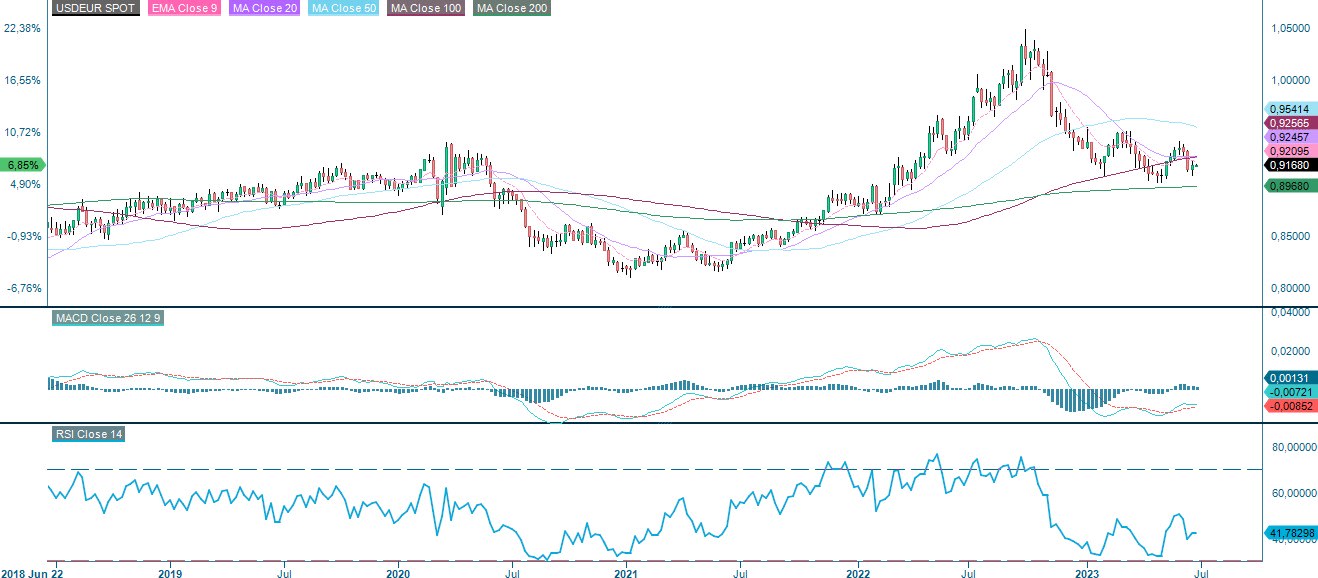
Market Comments: Low PMIs affect the market more than Wagner
US and European stock markets fell on Friday, 23rd June, after weaker-than-expected PMIs from France, Germany, the UK and the US.
Apart from a slight decline in oil prices, the Wagner Group military putsch in Russia on 24 June did not impact the markets. The unrest in Russia, a belligerent country with a sizeable nuclear arsenal, has not affected the VIX, which remains at remarkably low levels. One might ask what it takes to send the VIX higher, as that was not enough.
VIX, two-year daily chart
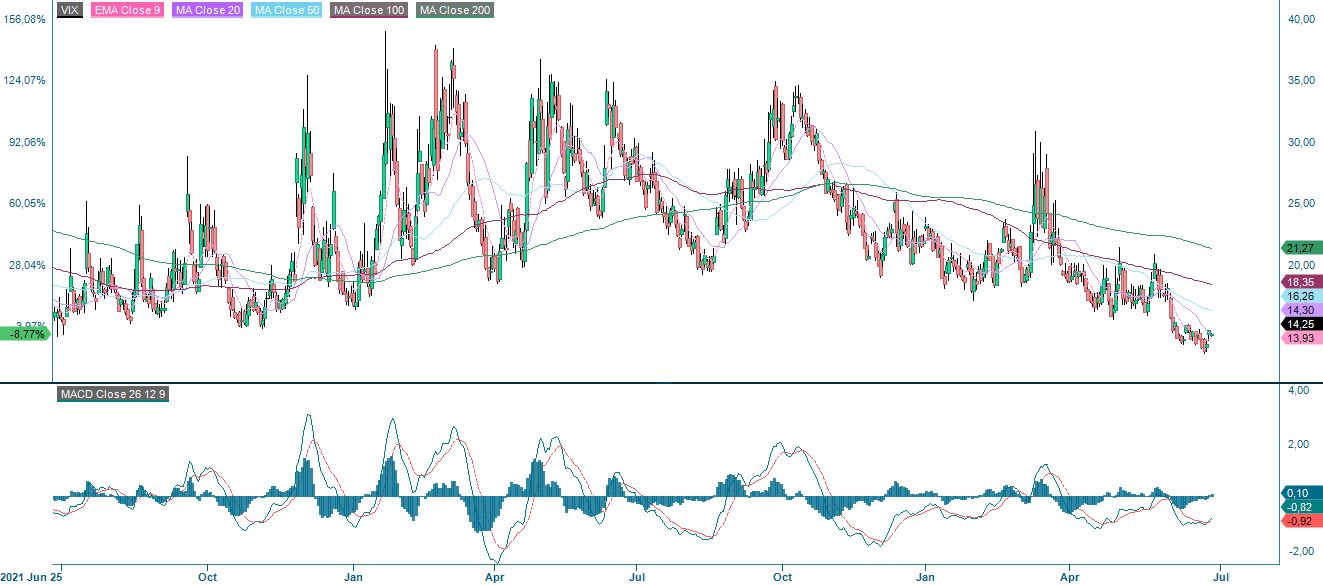
VIX, five-year weekly chart
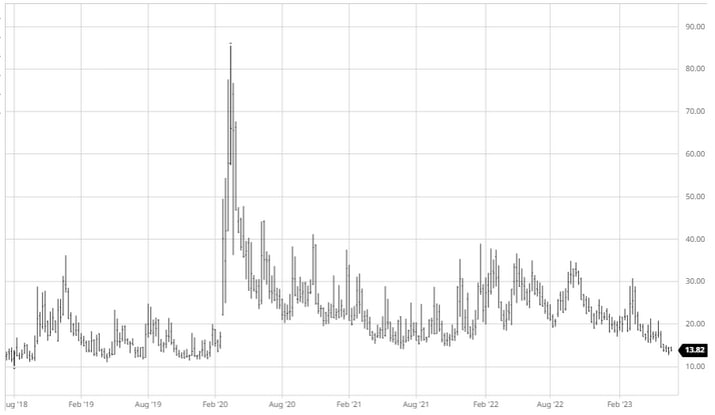
The market's appetite for risk remains low, as indicated by the fact that HYG (a US junk bond ETF) continues to trade in an increasingly narrow and lower range. The main drop occurred in the first half of 2022, when HYG fell by around 15 per cent.
HYG, three-year daily chart
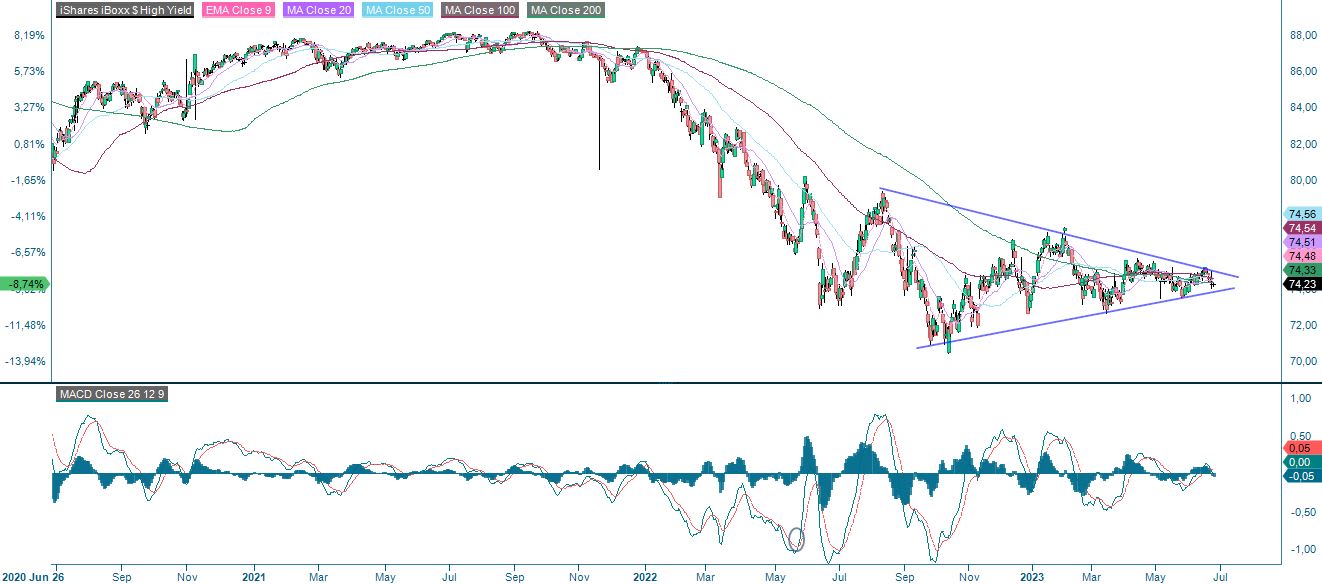
HYG, five year weekly chart

What’s next this week
Nike will release its quarterly results on Thursday, 29 June. Interest rate hikes have triggered weaker consumer spending. Nike's report will be an essential indicator of household sentiment and an early signal for the retail sector ahead of the Q2 2023 reporting period.
In Sweden, the focus will be on the Riksbank's interest rate announcement on Thursday, 29 June. The Riksbank is expected to raise interest rates by 25 basis points. However, there is some whispering of a 50 basis point hike. The Riksbank is also likely to take further measures to strengthen the krona and dampen imported inflation.
Following the hawkish signals from central banks, this week's US PCE inflation on Friday, 30 June, will be an essential data point for the market. The trend must continue to decline for the equity market to move higher. US Core PCE inflation is expected to land at 4.7% year-on-year, the same as last month.
Has the risk shifted to the downside?
Worries about the Fed’s aggressive rate politics have increased, and investors have sold off equities. S&P 500 is back down by the previous resistance level, which is now working as support. MA20 can be found at these levels to strengthen support just north of 3,200. However, one should note that MACD recently generated a soft sell signal. Thus, further downside risk is very much present from a technical point of view.
S&P500 price chart (in USD), two-year daily chart

S&P500 price chart (in USD), five-year weekly chart
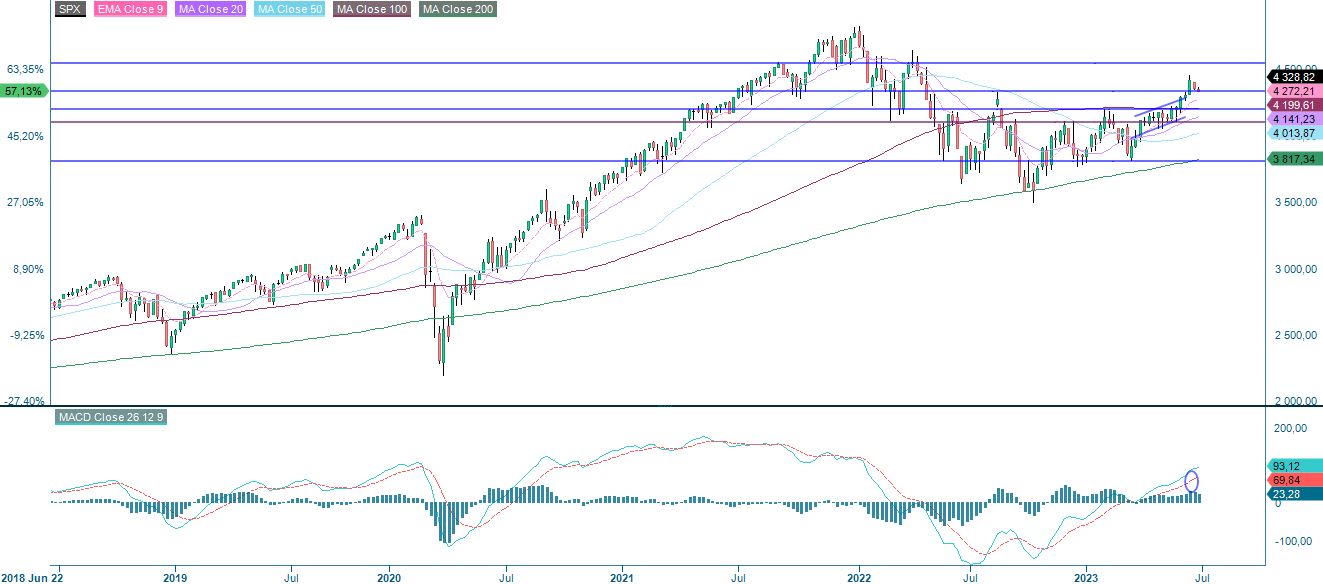
In the daily chart, a similar situation applies to the Nasaq 100, where MA20 is the first level of support. Again, MACD has generated a soft sell signal. Also worth noticing is RSI in the weekly chart, which is at overbought levels. However, RSI at overbought levels is not a sell signal per se. A potential break below 14,000, and this is looking a little scary.
Nasdaq 100 (in USD), two-year daily chart

Nasdaq 100 (in USD), weekly five-year chart

Microsoft is a heavy-weighter for both Nasdaq 100 and S&P 500. After failing to establish its share price above the new all-time high, momentum has been falling though still positive, as illustrated by MACD in the chart below. Are levels just south of 320 USD next, where support can be found in the daily and weekly chart?
Microsoft (in USD), two-year daily chart
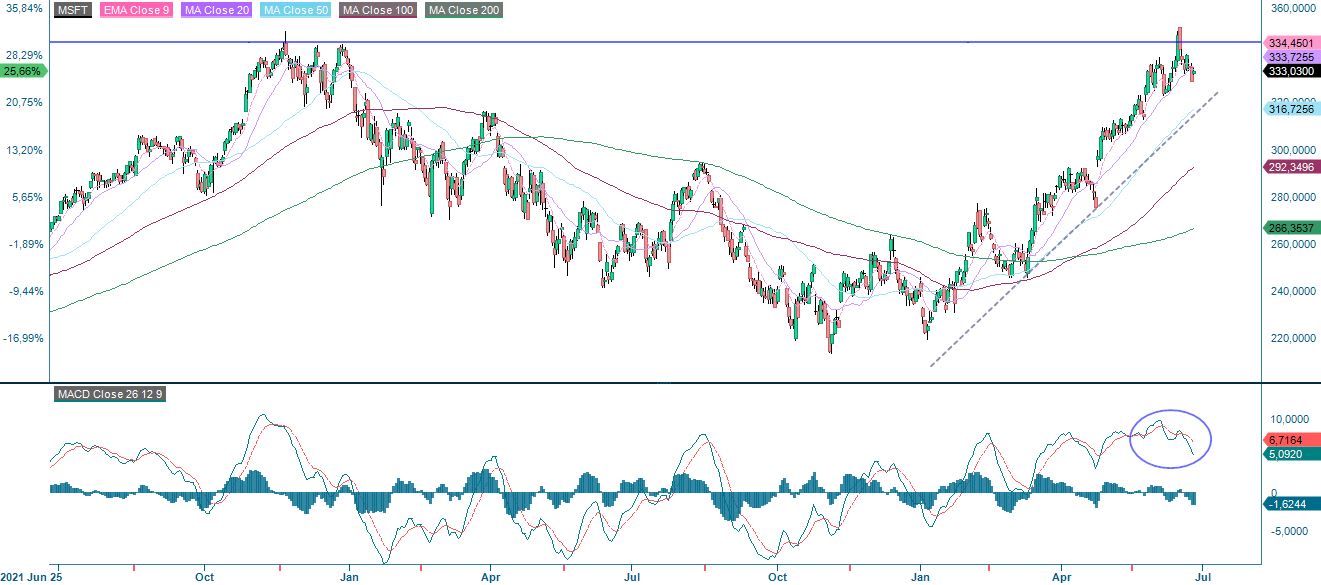
Microsoft (in USD), weekly five-year chart
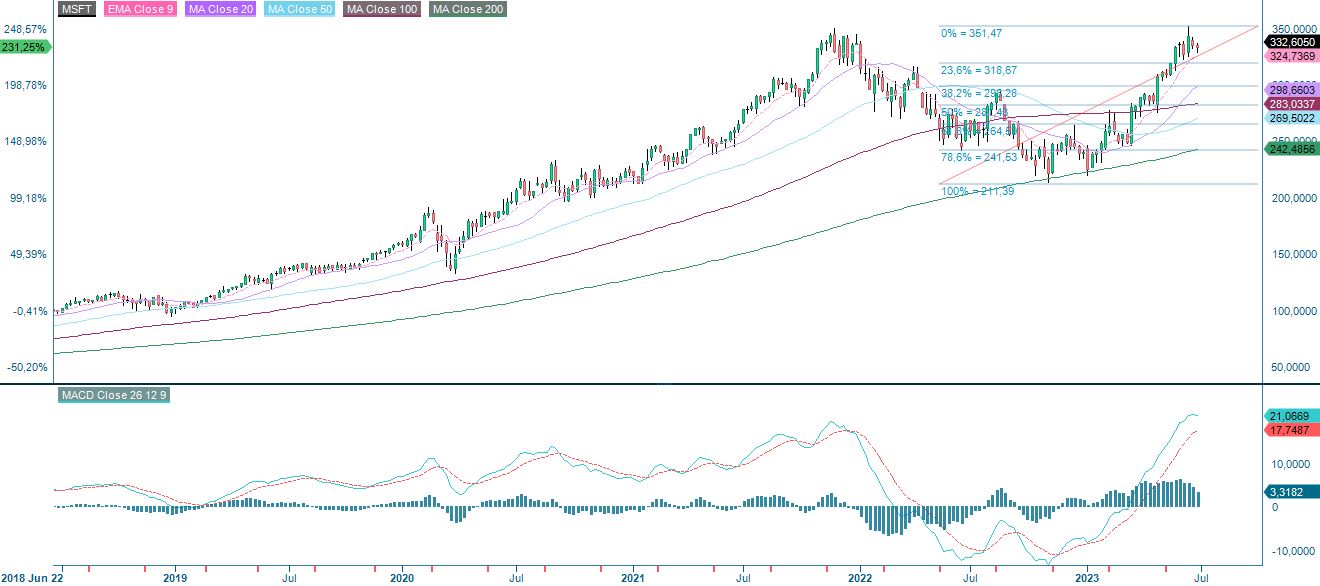
Small downside in OMXS30, but is the long-term trend at stake?
In the daily chart, OMXS30 is still hanging on to support made up by MA100 and the rising trendline. In case of a break, the downside is currently limited, as the next level is made up by Fibonacci 23.6 at 2,193. But fading momentum, as illustrated by MACD in the weekly chart, is somewhat worrisome for the long-term rising trend.
OMXS30 (in SEK), two-year daily chart
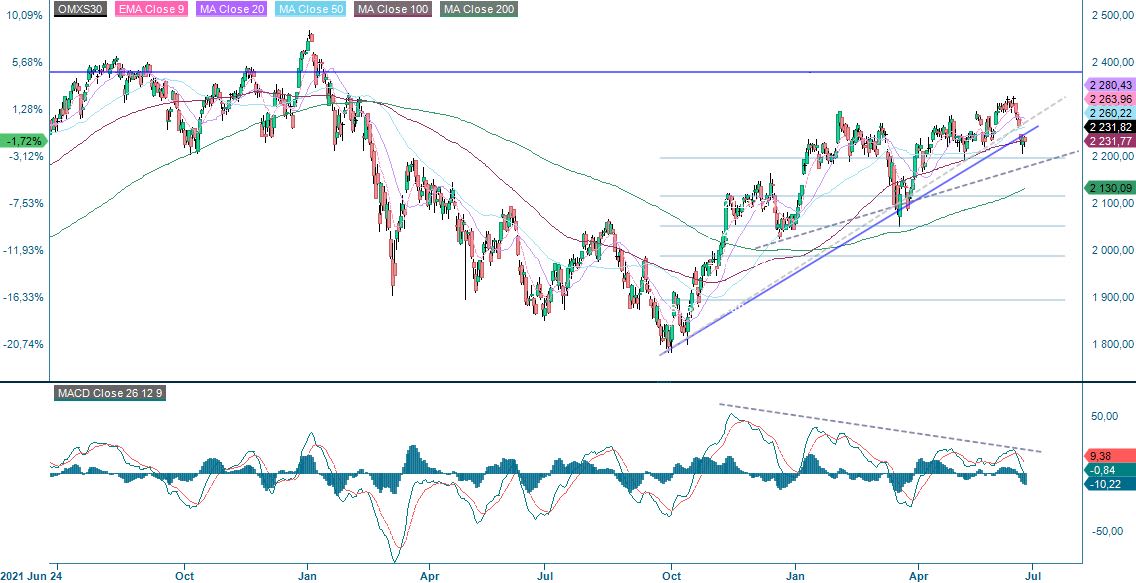
OMXS30 (in SEK), weekly five-year chart

The German DAX is like OMXS20 hanging on to support with limited downside risk, as the next level is around 15,377. Again, a fading momentum in the weekly chart is worrisome for the long-term rising trend.
DAX (in EUR), two-year daily chart

DAX (in EUR), weekly five-year chart

The full name for abbreviations used in the previous text:
EMA 9: 9-day exponential moving average
Fibonacci: There are several Fibonacci lines used in technical analysis. Fibonacci numbers are a sequence of numbers in which each successive number is the sum of the two previous numbers.
MA20: 20-day moving average
MA50: 50-day moving average
MA100: 100-day moving average
MA200: 200-day moving average
MACD: Moving average convergence divergence
Risks
Disclaimer:
This information is neither an investment advice nor an investment or investment strategy recommendation, but advertisement. The complete information on the trading products (securities) mentioned herein, in particular the structure and risks associated with an investment, are described in the base prospectus, together with any supplements, as well as the final terms. The base prospectus and final terms constitute the solely binding sales documents for the securities and are available under the product links. It is recommended that potential investors read these documents before making any investment decision. The documents and the key information document are published on the website of the issuer, Vontobel Financial Products GmbH, Bockenheimer Landstrasse 24, 60323 Frankfurt am Main, Germany, on prospectus.vontobel.com and are available from the issuer free of charge. The approval of the prospectus should not be understood as an endorsement of the securities. The securities are products that are not simple and may be difficult to understand. This information includes or relates to figures of past performance. Past performance is not a reliable indicator of future performance.
© Bank Vontobel Europe AG and/or its affiliates. All rights reserved.
External author:
This information is in the sole responsibility of the guest author and does not necessarily represent the opinion of Bank Vontobel Europe AG or any other company of the Vontobel Group. The further development of the index or a company as well as its share price depends on a large number of company-, group- and sector-specific as well as economic factors. When forming his investment decision, each investor must take into account the risk of price losses. Please note that investing in these products will not generate ongoing income.
The products are not capital protected, in the worst case a total loss of the invested capital is possible. In the event of insolvency of the issuer and the guarantor, the investor bears the risk of a total loss of his investment. In any case, investors should note that past performance and / or analysts' opinions are no adequate indicator of future performance. The performance of the underlyings depends on a variety of economic, entrepreneurial and political factors that should be taken into account in the formation of a market expectation.
